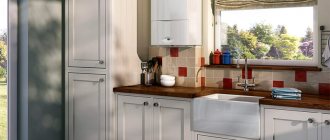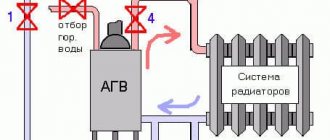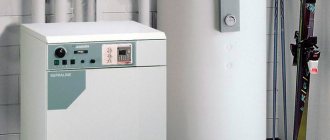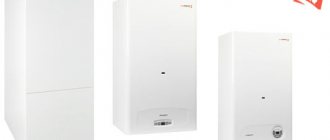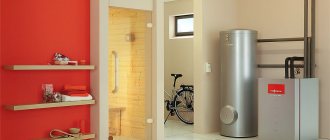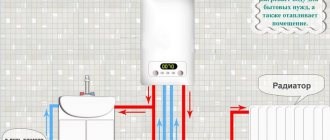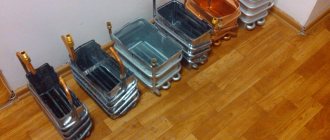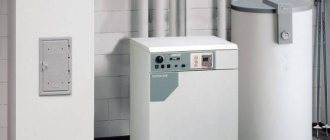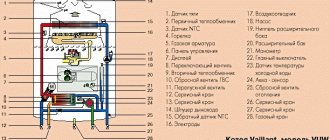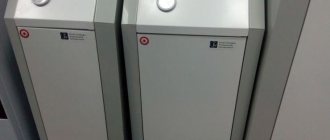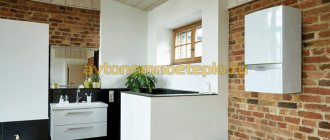Gas boilers are considered the most convenient and efficient sources of thermal energy.
Several design options have been developed that have remained virtually unchanged for many years.
Manufacturers create only certain variants of basic circuits based on the initially developed design.
All functions of the units are additions to the main type of gas boiler - a single-circuit floor-standing model designed to perform the main task.
Let's take a closer look at them.
Floor-standing single-circuit gas boilers and their features
The design of floor-standing single-circuit gas boilers is economical and simple.
They are capable of performing a single basic function - heating the coolant for the heating system . These units do not perform any additional tasks, therefore the set of units and parts of the unit is limited - only the most necessary elements are involved in the work.
In addition, the floor mounting method allows the use of durable and powerful units with increased weight and capabilities.
This makes the design more powerful and capable of high performance.
Most models are equipped with massive heat exchangers that have a high heat transfer capacity and can accommodate an increased volume of liquid. There are no restrictions on weight or dimensions for floor-standing boilers, so the power can be 100 kW or more.
Many units can be connected in a cascade (usually up to 4 units), creating a high-power thermal station.
Another feature of single-circuit floor-standing boilers is the ability to connect an external storage boiler.
This combination allows you to get not only heating of the house, but also a stable supply of hot water.
Most experts consider this option more preferable than using a double-circuit boiler, since the mode of supply of hot water from the boiler is smooth, without temperature jumps or pauses.
Advantages and disadvantages
The advantages of floor-standing single-circuit boilers include::
- simplicity, absence of unnecessary components and parts;
- reliability, stability;
- high power, ability to heat large areas;
- the presence of powerful and efficient heat exchangers with a high heat transfer coefficient;
- the floor mounting method simplifies the installation and connection of the unit;
- management of single-circuit models is simple and accessible to all users;
- There is a large selection of designs that allow you to obtain the most suitable type of boiler for the given conditions.
The disadvantages of floor-standing single-circuit boilers are:
- lack of independent ability to supply hot water;
- the specifics of the work require the allocation of a special room - a boiler room, equipped with window and door openings;
- atmospheric or non-volatile models are connected to the central common house chimney, which determines the location of their installation;
- increased power automatically means increased fuel consumption.
NOTE!
Most floor-standing single-circuit boilers are used in private homes or public spaces, where it is possible to provide all the conditions for the normal operation of the unit. The use of these models in apartments is impractical, since the dimensions and specific features of floor-standing boilers are excessive in such conditions.
Operating principle
The operation of a single-circuit floor-standing gas boiler consists of flow-through heating of the coolant using thermal energy obtained from fuel combustion.
The liquid enters the heat exchanger, receives the maximum possible heating for a given operating mode and enters a three-way valve . This is a unit where the hot coolant is mixed in a given proportion with the colder return flow.
The more return is added, the lower the temperature of the liquid entering the heating circuit. This is how the room heating mode is adjusted. The coolant moves under the action of a circulation pump, and the air supply and smoke removal are controlled by a turbofan.
The operation of all components is under continuous monitoring of a self-diagnosis system - a network of sensors installed on important components and parts of the boiler.
If abnormal situations occur or any elements fail, the sensors signal to the electronic control board, which immediately generates an error signal.
Some types of malfunctions cause immediate shutdown and blocking of the boiler for safety purposes; the control unit simply notifies the user about minor malfunctions.
IMPORTANT!
All problems that arise must be resolved only by qualified specialists with appropriate clearance. Unauthorized interference with the boiler design is an administrative offense.
Types of pumps for coolant circulation
There are several types of pumps that are installed in the heating systems of private houses:
…
- wet rotor pumps;
- dry rotor devices.
The circulation pump is a motor that is made of the following parts:
- stator - a stationary part, inside of which there are windings made of copper wire;
- rotor is the part that is in a movable state inside the stator.
When an electric current appears, an electromotive force arises, which stimulates the rotor to rotate.
Glandless rotor pump
The glandless pump is designed for use in water. To prevent short circuits of conductors in the electrical winding, the heating pump with this rotor is separated from the stator by a stainless steel housing.
The advantages of this pump are as follows:
- ease of use;
- low noise level;
- affordable price;
- It is possible to remove air from heating systems.
The disadvantages of a wet rotor pump are:
- low efficiency;
- ensuring only a small volume of water circulates.
Read here how to connect a wall-mounted gas boiler
Which floor-standing gas boilers are better - with a built-in or indirect boiler?
Which floor-standing gas boilers are considered the most reliable?
Dry rotor pump
The dry rotor pump is designed for use in large areas. Its rotor does not come into contact with the coolant due to the tightness of the seal. The advantages of this type of pump include:
- the ability to set movement to a large volume of liquid;
- It is possible to place the heating device in horizontal and vertical positions.
The disadvantages of a dry rotor are as follows:
- significant noise during operation;
- sealing parts require constant repair and lubrication.
What are its advantages of energy-dependent species
Non-volatile installations operate only on a mechanical principle, without needing to be connected to the power supply system.
This makes them indispensable in remote villages, in areas with dilapidated or overloaded electrical networks . Frequent shutdowns cause the heating to stop working, which is unacceptable in the Russian winter.
Non-volatile models ensure continuous heating of the house regardless of external conditions. However, such possibilities limit the capabilities of non-volatile boilers. They work only on natural physical processes - circulation of the coolant requires installation of the heating circuit at a slight angle and is based on the rise of warm layers of liquid upward.
Smoke removal occurs under the influence of normal draft in the chimney. It must be taken into account that natural processes occur with minimal intensity and are unstable, so external additional devices are usually installed - a turbo nozzle and a circulation pump.
They make the unit more productive, and operation in non-volatile mode occurs only during a power outage.
If there is no power supply to the house at all, only the basic capabilities of the unit are used.
Kinds
There are several design options for floor-standing single-circuit boilers. They differ from each other in various ways.
By type of combustion chamber:
- atmospheric (open) . The air directly surrounding the boiler is used, and the smoke is removed under the influence of natural draft. Such models are connected only to the central vertical chimney;
- turbocharged (closed) . To supply air and remove smoke, a coaxial type chimney is used (pipe in pipe), or two separate pipelines that perform the functions of intake and supply of air to the boiler and exhaust of flue gases.
According to heat exchanger material:
- steel. The most common option used on inexpensive models.
- copper. The coil-shaped design increases the path of liquid passing through the heating zone. Such units are installed in expensive models from top manufacturers;
- cast iron. Installed on powerful and massive units. Cast iron heat exchangers demonstrate high performance, efficiency, and are capable of developing large units of power. Used for units from 40 kW and above.
By heat transfer method:
- convection Conventional heating of the coolant in the flame of a gas burner;
- parapet. They are able to do without a heating circuit, being a kind of analogue of a conventional stove;
- condensation The coolant is heated in two stages - first in the condensation chamber, from the heat from the condensing flue gases, and then in the usual way.
NOTE!
Condensing boilers are able to fully operate only with low-temperature systems (warm floors), or when the difference in temperature outside and indoors is no more than 20°. These conditions are not suitable for Russia.
What characteristics of gas boilers exist?
There are heating units that consume only main gas, while others operate on both natural and liquefied fuel. The main technical characteristics of gas boilers are as follows:
- Location: floor, wall and parapet.
- Number of circuits: single-circuit and double-circuit.
- Type of ignition: electric ignition and piezo ignition.
- Burner type: atmospheric, pressurized, diffusion-kinetic.
- Type of traction: forced or natural.
- Heat exchanger material: cast iron, copper, steel.
- Combustion chamber: closed and open.
- Type of coolant: plain water and with the addition of antifreeze.
- Power.
Which boiler is better - wall-mounted or floor-mounted?
The main difference between floor-standing and wall-mounted boilers is the heat exchanger. For the former, it is more massive and is usually made of cast iron or high-alloy steel. A cast iron heat exchanger is easier to damage, but it can last for many years if used carefully. The steel element is stronger and weighs less.
Floor-standing boilers are large in size, their power can reach 3000 kW or more.
Wall-mounted boilers often have a heat exchanger made of copper or steel - they have a shorter service life. They are convenient to place in residential areas, as such units are compact in size and operate quietly.
How do single-circuit units differ from double-circuit units?
Single-circuit boilers are intended only for heating rooms without the ability to heat water.
…
Double-circuit ones are capable of both heating a home and providing hot water supply.
Note! Double-circuit gas boilers are designed in such a way that when the hot water supply is started, the power of the unit will be directed to heating water.
Boiler power
One of the main indicators of heating units is power. It determines whether your home will be warm and comfortable. The power indicator should be selected based on the estimated area that is planned to be heated and possible heat loss. They can be calculated using the formula:
Q = k • V • ΔT, where
Q – heat loss, kcal/h;
V – room volume, m³;
…
ΔT – maximum difference between the air temperature outside and inside the building in winter, °C;
k is the heat transfer coefficient of the house, which depends on the material of the walls (k = 0.5-1 – insulated structure, k = 1-2 – brickwork in two layers, k = 2-3 – brick wall in one layer, k = 3-4 – plank house.
Knowing the heat loss, calculate the required boiler power:
M= Q • k, where k is the safety factor, which ranges from 1.15 to 1.2.
When choosing boiler power, the following factors should be taken into account::
- The need to heat water. If you plan to purchase a double-circuit boiler and actively use hot water supply, you should increase the estimated power by 20-30%. It is known that when heating water, 70-80% of this indicator is spent.
- Water hardness - it affects the amount of scale on the surfaces of the heat exchanger. Significant limescale accumulations lead to a decrease in the productivity of the boiler. To avoid this, you should regularly clean the unit of scale, as well as soot and soot. The first cleaning is usually carried out after 2-3 years, but this period may vary depending on the quality of the water and the intensity of work.
Which type of combustion chamber should I choose?
As already mentioned, there are gas boilers with open and closed combustion chambers. The first type consumes oxygen, which supports the combustion process, directly from the room. Combustion products go there too. Therefore, an open chamber requires a chimney and high-quality ventilation. Such units are mainly installed in specially equipped boiler rooms.
Note! An open combustion chamber is a feature of floor-standing boilers with a power of over 35 kW.
For units with a closed combustion chamber, air supply and smoke exit occur through a coaxial chimney. It consists of two pipes, one of which is located inside the other. Through one of them, air enters the boiler, and through the other, combustion products are forced out. Mainly wall-mounted boilers with a power of less than 35 kW are equipped with closed combustion chambers.
Do you need a boiler?
The need to connect a boiler is dictated by the needs of the room and users
If the unit operates in a private house, then installing a boiler will allow you to organize the supply of hot water in sufficiently large volumes.
However, if there is a connection to a centralized water supply, purchasing an external boiler seems impractical.
Removal of combustion products
Depending on the type of burner, the smoke removal method is selected. If the gas boiler is equipped with an atmospheric burner (open type), for which air is taken from the room, then the installation of a classic chimney will be required. If the unit is equipped with a turbocharged burner (closed type), then installing a compact coaxial chimney will be sufficient. It will ensure the supply of oxygen necessary for the combustion process, as well as convenient smoke removal.
Note! For floor-standing boilers with an atmospheric burner, a separate room (boiler room) will be required, and units with a closed chamber can be installed in the living room.
The efficiency of gas boilers with a closed burner is higher than with an open one.
The most popular manufacturers and their brief descriptions
The leading manufacturers of floor-standing single-circuit boilers are European companies, although domestic designs are optimal for Russian conditions.
The most famous companies are:
- Viessmann. A German company, one of the most famous and reliable companies producing thermal products;
- Protherm. A company from Slovakia that produces a wide range of heating boilers. ALL series are named after animals of different species;
- Buderus . “Daughter” of the world-famous concern Bosh, which fully characterizes the quality and reliability of the products;
- Vaillant. Another German company whose boilers are considered the highest quality and most reliable;
- Lemax. Russian manufacturer of energy-independent floor-standing gas boilers. When developing the project, all the features of working in difficult conditions were taken into account;
- Navien. Korean boilers that successfully combine high quality and affordable prices.
The list of manufacturers can be continued for a very long time. All currently operating companies care about the quality and reliability of their products, trying to surpass competitors and reach the maximum number of users.
Which boiler manufacturer should I choose?
The price of a floor-standing gas boiler depends not only on its characteristics, but also on the manufacturer. Units manufactured abroad :
- Bosch is a German manufacturer that offers atmospheric models Bosch Gaz and condensing Bosch Condens;
- Viessmann have a power of up to 160 kW, have a series of atmospheric and condensing types;
- Buderus - the model range has a power of up to 300 kW, boilers from this German manufacturer are characterized by low noise levels;
- Vaillant, manufactured in Germany, presents the VK INT series with an open firebox, ecoVIT and ecoCOMPACT - condensing models; unit power up to 160 kW, efficiency not less than 94%;
- BAXI - Italian boilers with an efficiency of at least 90%; units with an open firebox are produced under the name SLIM, closed ones - Galaxy;
- Protherm are Slovak units, the floor models of which are represented by the Bear and Wolf series.
Note! Before purchasing a gas unit from a certain manufacturer, check whether there are service centers of this company in your city.
Domestic gas boilers produced will cost less than foreign ones :
- Rostovgazoapparat is one of the oldest boiler equipment factories; produces single- and double-circuit units with steel and cast iron heat exchangers;
- Zhukovsky plant - they are characterized by energy independence; produces Zhuk, Comfort and Universal boilers;
- Lipetsk company, which produces about 30 models of floor-standing devices with a power of 11 kW and above.
To correctly determine which gas floor-standing boiler is best to choose, you should clearly know the device with what characteristics you need. The more features and functions a gas boiler has, the more expensive it is. However, automation makes the heating device too dependent on electricity; it will not be able to fully operate in regions where power outages often occur.
If you believe the reviews, it is better to choose a floor-standing gas boiler from a reliable foreign manufacturer, for example, Protherm, Bosch, Buderus.
Rating of TOP 10 best models
| Place | Name | Price |
| TOP 5 best Russian floor-standing single-circuit boilers | ||
| 1 | Lemax Premium-20 | 25 000 ₽ |
| 2 | Lemax Premium-12.5 | 21 000 ₽ |
| 3 | Lemax Leader-35 | 53 000 ₽ |
| 4 | ZhMZ AOGV-17.4-3 Comfort N | 21 000 ₽ |
| 5 | Rostovgazoapparat AOGV | 20 000 ₽ |
| TOP 5 best foreign floor-standing single-circuit boilers | ||
| 1 | Protherm Wolf 16 KSO | 19 000 ₽ |
| 2 | BAXI SLIM 1.230 iN | 55 000 ₽ |
| 3 | MORA-TOP SA 20 G | 30 000 ₽ |
| 4 | MORA-TOP SA 60 | 25 000 ₽ |
| 5 | Protherm Bear 40 KLOM | 57 000 ₽ |
The best Russian floor-standing single-circuit boilers
Let's look at the most popular models of Russian floor-standing gas boilers:
Lemax Premium-20
Products of the plant of the same name from Taganrog. A non-volatile floor-standing boiler with a power of 20 kW is capable of heating a house of 200 square meters. m.
Its main characteristics:
- Efficiency - 90%;
- coolant temperature (max) - 90°;
- heating system pressure (max) - 3 Bar;
- fuel consumption - 2.4 m3/hour;
- dimensions - 556x961x470 mm;
- weight - 78 kg.
The high demand for Lemax boilers indicates the demand and positive attitude of users towards domestic heating units.
Lemax Premium-12.5
Another representative of the Taganrog plant, designed for work in relatively small spaces. With a power of 12.5 kW, this boiler can heat an area of 125 square meters. m., which is suitable for country houses or country houses.
Unit parameters:
- Efficiency - 90%;
- coolant temperature - 90°;
- heating system pressure (max) - 3 Bar;
- fuel consumption - 1.5 m3/hour;
- dimensions - 416x744x491 mm;
- weight - 60 kg.
The boiler is relatively small, but its capabilities allow you to get the maximum effect.
Lemax Leader-35
Powerful (35 kW) floor-standing boiler, capable of serving a house or public space of 350 square meters. m. The combustion chamber is open type, which requires connection to the central chimney.
Other parameters:
- Efficiency - 90%;
- coolant temperature - 95°;
- heating system pressure (max) - 4 Bar;
- fuel consumption - 4 m3/hour;
- dimensions - 600x856x520 mm;
- weight - 140 kg.
A special feature of this model is a cast iron heat exchanger, which provides high heat transfer and stable heating mode.
ZhMZ AOGV-17.4-3 Comfort N
Product of the Zhukovsky Mechanical Plant. Power 17.4 kW, which is designed to heat 140 sq. m. The non-volatile design makes the unit resistant to all changes in the situation.
Boiler parameters:
- Efficiency - 88%;
- coolant temperature - 90°;
- heating system pressure (max) - 1 Bar;
- fuel consumption - 1.87 m3/hour;
- dimensions - 420x1050x480 mm;
- weight - 49 kg.
If necessary, the boiler can be reconfigured to be powered by liquefied gas, which further increases its autonomy.
Rostovgazoapparat AOGV
A unit from the Rostov plant with a power of 11.6 kW. Designed for heating 125 sq. m. usable area.
Its operating parameters:
- Efficiency - 90%;
- coolant temperature - 95°;
- heating system pressure (max) - 1 Bar;
- fuel consumption - 1.18 m3/hour;
- dimensions - 410x865x410 mm;
- weight - 49 kg.
The unit differs from other models in its cylindrical shape, which looks somewhat old-fashioned. However, this does not affect the quality and parameters of the boiler in any way.
How to choose a floor-standing gas boiler?
Focus on the following parameters:
- Power . An average power reserve will allow the boiler to last not 1 or 2 years, but significantly longer. Add 25% to the optimal power indicator, and the result will be the very figure from which you should build.
- Material of manufacture . Gas boilers made of cast iron last the longest. But get ready to shell out a hefty sum for such a boiler.
- Device type . A condensing boiler is cheaper and more economical.
- Management . Choose a model with manual temperature control: sooner or later you will want to choose the appropriate indicators yourself.
- Safety . The boiler must have protection systems: gas control (which turns off the unit if there is a gas leak), protection against hypothermia and overheating.
Popular manufacturers of gas boilers: Neva, Lemax, ZhMZ, Navien, Protherm, Baxi, Viessmann, Buderus, Vaillant.
The best foreign floor-standing single-circuit boilers
Let's look at the most popular models from Western manufacturers:
Protherm Wolf 16 KSO
The brainchild of Slovak engineers, the Volk 16 KSO floor-standing boiler is designed for heating medium-sized private houses. With a power of 16 kW it can heat 160 sq. m.
Main characteristics:
- Efficiency - 92.5%;
- coolant temperature - 80°;
- heating system pressure (max) - 1 Bar;
- fuel consumption - 2.4 m3/hour;
- dimensions - 390x745x460 mm;
- weight - 46.5 kg.
The unit is non-volatile, which is not typical for European models - they prefer fully functional designs. In addition, it is equipped with a two-pass heat exchanger, which increases the performance of the unit.
BAXI SLIM 1.230 iN
Italian boiler from a famous European manufacturer. Its power is 22.1 kW, designed to operate in a room of 220 sq.m.
Boiler characteristics:
- Efficiency - 90.2%;
- coolant temperature - 85°;
- heating system pressure (max) - 3 Bar;
- fuel consumption - 2.59 m3/hour;
- dimensions - 350x850x600 mm;
- weight - 103 kg.
The heat exchanger of this boiler is made of ductile cast iron, the warranty period is 2 years.
MORA-TOP SA 20 G
Czech engineers offer users a 15 kW boiler capable of heating 150 square meters. m. area. A cast iron heat exchanger stabilizes the operation of the system and equalizes the temperature, eliminating sudden jumps.
Boiler parameters:
- Efficiency - 92%;
- coolant temperature - 85°;
- heating system pressure (max) - 3 Bar;
- fuel consumption - 1.6 m3/hour;
- dimensions - 365x845x525 mm;
- weight - 99 kg.
An additional advantage is the non-volatile design, which expands the capabilities of the unit in difficult conditions.
MORA-TOP SA 60
Another Czech boiler with a capacity of 49.9 kW. Suitable for heating a house of 500 square meters. m., as well as for public or commercial premises.
Unit characteristics:
- Efficiency - 92%;
- coolant temperature - 85°;
- heating system pressure (max) - 3 Bar;
- fuel consumption - 5.8 m3/hour;
- dimensions - 700x845x525 mm;
- weight - 208 kg.
The boiler is equipped with a cast iron heat exchanger consisting of 7 sections. Electronic controls provide constant control over the operating mode of the system.
Protherm Bear 40 KLOM
Slovak floor-standing unit with a power of 35 kW. Heating area - 350 sq. m.
- Efficiency - 90%;
- coolant temperature - 85°;
- heating system pressure (max) - 4 Bar;
- fuel consumption - 4.1 m3/hour;
- dimensions - 505x880x600 mm;
- weight - 130 kg.
The features of the boiler include the design of the heat exchanger - it is a cast iron two-pass unit of 5 sections.
How to determine the power of a gas boiler?
The main characteristic of a gas boiler is its power. Under ideal conditions, its indicator is calculated as 1 kW for every 10 m² of a room where the ceiling height does not exceed 3 m. However, it must be borne in mind that the power in this way is determined for a well-insulated structure, without taking into account water heating and at normal pressure in the gas pipeline of about 15 mbar. It is necessary to carefully analyze all possible factors that require an increase in power. In most cases, to heat a home, you will need a unit whose power is 1.5-1.7 times greater than that required under ideal conditions.
Also, to calculate this indicator, you should take into account the minimum winter temperature in your region, the number of windows and doors, as well as their thermal conductivity.
To get the most accurate calculation, it is better to contact specialists - they will develop an individual project, taking into account all the features of the house and external conditions.
Note! When choosing a gas boiler, it is advisable to pay attention to its minimum power indicator. The smaller this value, the more economical the unit will operate.
